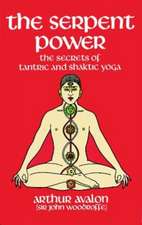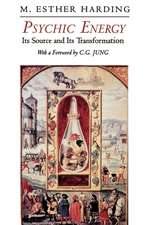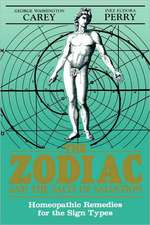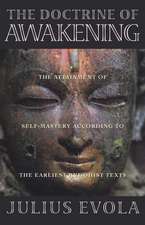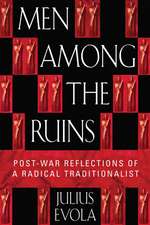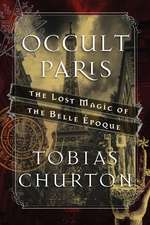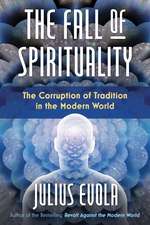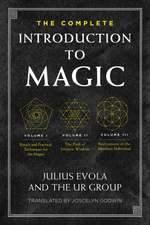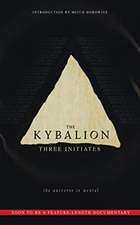The Hermetic Tradition: Symbols and Teachings of the Royal Art
Autor Julius Evolaen Limba Engleză Paperback – 1995
First published in 1931 in Italian. This is the first English translation.
Draws from a host of sources in the Western esoteric tradition--works on theurgy, magic, and gnosticism from neoplatonic, Arab, and medieval sources.
Preț: 105.17 lei
Nou
Puncte Express: 158
Preț estimativ în valută:
20.13€ • 21.85$ • 16.91£
20.13€ • 21.85$ • 16.91£
Carte disponibilă
Livrare economică 01-15 aprilie
Preluare comenzi: 021 569.72.76
Specificații
ISBN-13: 9780892814510
ISBN-10: 0892814519
Pagini: 240
Dimensiuni: 152 x 229 x 18 mm
Greutate: 0.34 kg
Ediția:Original
Editura: Inner Traditions/Bear & Company
Colecția Inner Traditions
ISBN-10: 0892814519
Pagini: 240
Dimensiuni: 152 x 229 x 18 mm
Greutate: 0.34 kg
Ediția:Original
Editura: Inner Traditions/Bear & Company
Colecția Inner Traditions
Notă biografică
Baron Julius Evola (1898 - 1974), born into an aristocratic Sicilian family, was a scholar, philosopher, writer, social thinker, a leader among 20th century Hermeticists, and a leading authority on Tantra and occultism. He is the author of Eros and the Mysteries of Love, The Doctrine of Awakening, Meditations on the Peaks, The Mystery of the Grail, Revolt Against the Modern World and The Yoga of Power.
Cuprins
The Hermetic Tradition
Symbols & Teachings of the Royal Art
Foreword by H. T. Hansen
Translator's Note
Preface
Part 1: The Symbols and Teachings
Introduction to Part One: The Tree, the Serpent, and the Titans
1. The Plurality and Duality of Civilizations
2. Living Nature
3. The Hermetic Knowledge
4. "One the All" and the Dragon Ouroboros
5. The Hermetic Presence
6. Creation and Myth
7. "Woman," "Water," "Mercury," and "Poison"
8. The Separation: Sun and Moon
9. Frozen and Flowing Waters
10. Salt and the Cross
11. The Four Elements and Sulfur
12. Soul, Spirit, and Body
13. The "Four" in Man
14. The Planets
15. The Centers of Life
16. The Seven, the Operations, and the Mirror
17. Gold in the Art
18. Shadow, Ashes, and Remains
19. Philosophical Incest
20. The Tomb and Thirst
21. Saturn: Inverted Gold
22. The Field and the Seed
23. The Sword and the Rose
24. Stem, Virus, and Iron
Part 2: The Hermetic Royal Art
Introduction to Part 2: The Reality of Palingenesis
25. The Separation
26. Death and the Black Work
27. The Trial of the Void
28. The Flight of the Dragon
29. The Dry Path and the Wet Path
30. Hermetic Asceticism
31. The Path of the Breath and the Path of the Blood
32. The Heart and the Light
33. Denudations and Eclipses
34. The Thirst for God and the Corrosive Waters
35. The Path of Venus and the Radical Path
36. The Hermetic Fires
37. The White Work: Rebirth
38. The Coniunctio in White
39. The Eternal Vigil
40. The Body of Light and Production of Silver
41. Birth into Life and Immortality
42. The Red Work: Return to Earth
43. The Alchemical Colors and Multiplication
44. The Planetary Hierarchy
45. Knowledge of the Red and the Triunity
46. Prophetic Knowledge
47. The Four Stages of Power
48. Metallic Transmutation
49. Correspondences, Times, and Rites
50. Silence and the Tradition
51. The Invisible Masters
Index
Symbols & Teachings of the Royal Art
Foreword by H. T. Hansen
Translator's Note
Preface
Part 1: The Symbols and Teachings
Introduction to Part One: The Tree, the Serpent, and the Titans
1. The Plurality and Duality of Civilizations
2. Living Nature
3. The Hermetic Knowledge
4. "One the All" and the Dragon Ouroboros
5. The Hermetic Presence
6. Creation and Myth
7. "Woman," "Water," "Mercury," and "Poison"
8. The Separation: Sun and Moon
9. Frozen and Flowing Waters
10. Salt and the Cross
11. The Four Elements and Sulfur
12. Soul, Spirit, and Body
13. The "Four" in Man
14. The Planets
15. The Centers of Life
16. The Seven, the Operations, and the Mirror
17. Gold in the Art
18. Shadow, Ashes, and Remains
19. Philosophical Incest
20. The Tomb and Thirst
21. Saturn: Inverted Gold
22. The Field and the Seed
23. The Sword and the Rose
24. Stem, Virus, and Iron
Part 2: The Hermetic Royal Art
Introduction to Part 2: The Reality of Palingenesis
25. The Separation
26. Death and the Black Work
27. The Trial of the Void
28. The Flight of the Dragon
29. The Dry Path and the Wet Path
30. Hermetic Asceticism
31. The Path of the Breath and the Path of the Blood
32. The Heart and the Light
33. Denudations and Eclipses
34. The Thirst for God and the Corrosive Waters
35. The Path of Venus and the Radical Path
36. The Hermetic Fires
37. The White Work: Rebirth
38. The Coniunctio in White
39. The Eternal Vigil
40. The Body of Light and Production of Silver
41. Birth into Life and Immortality
42. The Red Work: Return to Earth
43. The Alchemical Colors and Multiplication
44. The Planetary Hierarchy
45. Knowledge of the Red and the Triunity
46. Prophetic Knowledge
47. The Four Stages of Power
48. Metallic Transmutation
49. Correspondences, Times, and Rites
50. Silence and the Tradition
51. The Invisible Masters
Index
Recenzii
"This book has been hailed as one of the clearest works on alchemy ever written."
"The Hermetic Tradition is not a book to be read once for the value of its information about European alchemy--which admittedly is great--but to be revisited as one's own alchemical work, in whatever form, proceeds. Each reading will bring new levels of insight."
"Evola is a major force in the area of modern European esotericism, but is little known in the English speaking world. Author of numerous works on esoteric practices and philosophy, Evola is a name that all serious students of esotericism should be familiar with. Evola discloses in clear and meaningful terms the ideas present and their use in practice. Evola is not for the feint of heart or brain however. He deals with difficult subjects and presents them in an intelligent and experienced manner. Anyone seeking a literary initiation into the world of deep thought and practices can do no better than to start with Evola."
"An extremely cogent elucidation of the alchemical Great Work."
"This book is a good place to use as a center for your alchemical studies."
"Evola writes serious books about serious subjects, yet manages to present the material in a manner that is both meaningful and practical. . . . occultists who want to understand a man who was a major force in Italian esotericism . . . will find a wealth of knowledge and esoteric insight."
"Considered one of the clearest and strongest works on the art of Alchemy ever written."
"The Hermetic Tradition is not a book to be read once for the value of its information about European alchemy--which admittedly is great--but to be revisited as one's own alchemical work, in whatever form, proceeds. Each reading will bring new levels of insight."
"Evola is a major force in the area of modern European esotericism, but is little known in the English speaking world. Author of numerous works on esoteric practices and philosophy, Evola is a name that all serious students of esotericism should be familiar with. Evola discloses in clear and meaningful terms the ideas present and their use in practice. Evola is not for the feint of heart or brain however. He deals with difficult subjects and presents them in an intelligent and experienced manner. Anyone seeking a literary initiation into the world of deep thought and practices can do no better than to start with Evola."
"An extremely cogent elucidation of the alchemical Great Work."
"This book is a good place to use as a center for your alchemical studies."
"Evola writes serious books about serious subjects, yet manages to present the material in a manner that is both meaningful and practical. . . . occultists who want to understand a man who was a major force in Italian esotericism . . . will find a wealth of knowledge and esoteric insight."
"Considered one of the clearest and strongest works on the art of Alchemy ever written."
Descriere
This important survey of alchemical symbols and doctrines sets forth the mysterious worldview and teachings of the practitioners of the "royal art.

